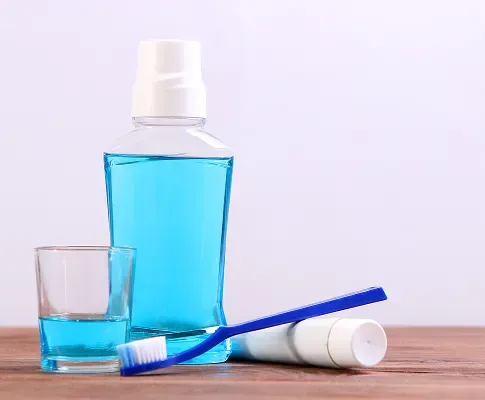
Tooth Sensitivity in Adults: How Your Dentist Uses Fluoride to Reduce It?
21 August 2025
Tooth sensitivity in adults is a growing concern—especially among those who’ve undergone restorative dental work like crowns, bridges, or composite fillings. The good news? There’s an effective and preventative solution your dentist may recommend: fluoride treatment for dental restorations.
While fluoride is commonly associated with children’s cavity prevention, today’s dentists are using it increasingly in adult fluoride dental care—particularly to prevent decay around restorations. Whether you’ve recently had a filling or are managing dental crowns and bridges, this targeted treatment is vital in safeguarding your investment and oral health.

Why Tooth Sensitivity Happens After Dental Work
If you’ve ever asked, "Why are my teeth more sensitive after a crown or filling?"—you’re not alone. Procedures that involve tooth reduction or bonding can expose the inner dentin layers or stress the tooth enamel, leading to short-term or chronic sensitivity.
Additionally, recurrent decay—decay that develops around the edges of restorations—can increase sensitivity and jeopardize the integrity of your dental work. This is where fluoride to protect fillings and bridges becomes critical.
The Role of Fluoride in Restorative Dental Care
What Is Fluoride and Why It Matters in Adulthood?
Fluoride is a naturally occurring mineral that helps remineralize enamel, reduce sensitivity, and make teeth more resistant to acid attacks. For adults who have undergone restorative dentistry, fluoride offers far more than general protection—it’s tailored prevention.
Can fluoride protect dental crowns and fillings?
Absolutely. When used correctly, fluoride reinforces the areas where restorations meet natural enamel, which are prone to bacteria and decay.
How Dentists Use Fluoride to Protect Restorations
Professional Fluoride Varnish Applications
One of the most effective methods is the application of fluoride varnish for crowns and other restorations. Your dentist may use a sodium fluoride-based varnish post-treatment or during routine cleanings.
This varnish adheres to both enamel and restorative material, forming a long-lasting protective layer. It is especially beneficial for exposed root surfaces, the margins of composite fillings, and areas under dental bridges or around dental crowns.
Targeted Adult Fluoride Dental Care
For adults, fluoride isn’t a one-size-fits-all solution. Dentists customize fluoride maintenance for dental restorations based on several factors, including the number and type of restorations such as crowns, bridges, or inlays, as well as the presence of enamel erosion or gum recession. A history of recurrent decay also plays a significant role in determining the level of care needed. Adults with dental bridges benefit greatly from fluoride treatment, particularly when the bridge spans multiple teeth or is positioned near areas that have experienced decay before. This personalized approach helps protect vulnerable areas, strengthen remaining tooth structure, and extend the life of both natural teeth and restorative work.
Fluoride and Dental Work Longevity: The Current Consensus
What the ADA Recommends
The American Dental Association (ADA) supports fluoride use for adults with restored teeth. Research shows it can extend the life of fillings and crowns, reduce sensitivity, and help prevent decay around restorations, protecting both dental work and natural teeth.
Restorative Dental Fluoride: A Long-Term Strategy
Think of fluoride as the maintenance check-up for your dental restorations. Just as you wouldn’t ignore oil changes in a car, avoiding fluoride treatments may lead to early failure of expensive dental work.
Is fluoride effective for restored teeth?
Yes—especially when applied regularly as part of a professional care plan.
Boosting Dental Work Longevity with At-Home and In-Office Fluoride
How to Prevent Decay Around Dental Restorations
In-office fluoride varnishes are highly effective, but combining them with at-home care ensures the best results. Your dentist may recommend daily use of prescription-strength fluoride toothpaste, a high-fluoride mouth rinse for added protection—especially if you have bridges or crowns—and dietary adjustments to limit acidic and sugary foods that erode enamel. Fluoride after dental work isn’t optional; it’s essential for protecting natural tooth structure, preventing decay around restorations, and ensuring the long-term health and durability of your dental work.
The Fluoride Advantage for Different Dental Restorations
Fluoride for Adults with Crowns
Crowns often cover teeth that were once severely decayed or cracked. These teeth remain vulnerable at the gum line and underneath the crown. Using fluoride for adults with crowns helps:
- Seal the margins to block decay
- Strengthen the underlying tooth structure
- Prevent leakage that leads to sensitivity
Fluoride to Protect Fillings and Bridges
Dental bridges span gaps and rest on adjacent teeth—areas prone to food traps and decay. Fluoride reinforces those support teeth and protects any composite fillings beneath the bridge from recurrent decay.
Innovation in Fluoride Treatment: What’s New for Restored Teeth?
Advancements in Restorative Dental Fluoride
While traditional sodium fluoride remains a staple, newer formulations and delivery methods are being developed to improve patient outcomes. Dentists now use enhanced fluoride varnish formulations that adhere better to dental crowns, bridges, and composite fillings, delivering longer-lasting protection.

Need Any Help?
Contact UsNano-Fluoride and Gel-Based Solutions
Emerging technologies like nano-fluoride particles allow deeper penetration into tooth enamel, strengthening areas around restorations. Gel-based fluoride applications are also becoming more common for patients with extensive dental work, particularly those seeking extra protection from recurrent decay.
When Should You Get a Fluoride Treatment After Dental Work?
Timing Your Fluoride Maintenance
If you’ve recently undergone restorative dentistry, such as the placement of dental crowns or bridges, fluoride treatment should follow shortly after. This ensures protection during the early vulnerable stage, especially at restoration margins.
Frequency Matters
Depending on your risk level, your dentist might suggest fluoride treatment:
- Every 3–6 months for patients with multiple restorations
- Annually for lower-risk adults with stable oral hygiene
- Alongside other preventive strategies, especially if you experience sensitivity
Fluoride maintenance for dental restorations is not a one-time solution—it’s a long-term approach tailored to your dental history.
Fluoride and Dental Restorations
Fluoride plays a vital role in protecting teeth, even for adults with crowns, fillings, and bridges. While restorations themselves do not decay, the natural tooth structure around them remains vulnerable. Fluoride strengthens these areas and helps prevent recurrent decay. For patients with bridges, fluoride is essential, as supporting teeth can be more challenging to clean and are prone to damage. Clinical studies confirm that fluoride reduces sensitivity and supports the longevity of dental restorations, particularly as they age. To prevent decay, adults should brush twice daily with fluoride toothpaste, floss around and under bridges and crowns, use prescription rinses if recommended, and visit the dentist regularly for varnish applications and thorough check-ups.
Final Thoughts
Fluoride isn’t just for children—it’s an essential part of adult dental care, especially for those with crowns, bridges, or composite fillings. With the increasing number of adults undergoing restorative treatments, the need for proactive protection is greater than ever. Incorporating fluoride treatment for dental restorations into your routine plays a vital role in preventing tooth decay in restored teeth, helping to shield vulnerable areas and extend the life of your dental work. Backed by the American Dental Association (ADA) and supported by trusted methods like fluoride varnish, fluoride enhances the durability of tooth enamel, seals margins around dental crowns, and minimizes the risk of recurrent decay. From bridge protection to filling maintenance, fluoride continues to prove its value in modern dentistry. If you’ve ever wondered, “Can fluoride protect dental crowns and fillings?”—the answer is a confident yes. Speak with your dentist about integrating a targeted adult fluoride dental care plan that supports long-term oral health and ensures your restored teeth stay healthy and strong.
Resource:
Stronger Enamel at Any Age: Why Adults Benefit from In-Office Fluoride Treatments
Disclaimer
*This media/content or any other on this website does not prescribe, recommend, or prevent any treatment or procedure. Therefore, we highly recommend that you get the advice of a qualified dentist or other medical practitioners regarding your specific dental condition. *
